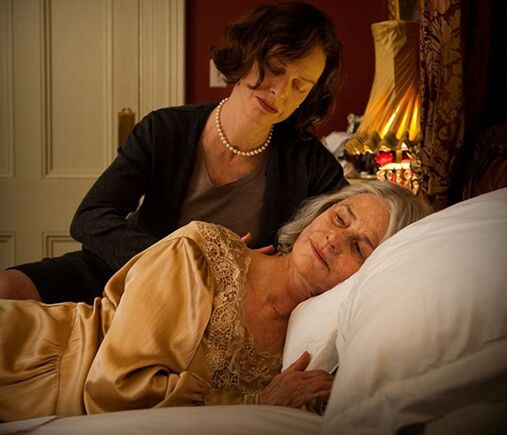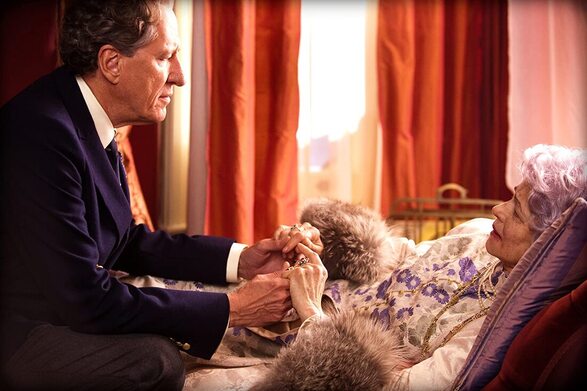THE EYE OF THE STORM
****
Director: Fred Schepisi
Screenwriter: Judy Morris - adapted from the eponymous novel by Patrick White
Principal cast:
Charlotte Rampling
Geoffrey Rush
Judy Davis
John Gaden
Alexandra Schepisi
Robyn Nevin
Country: Australia
Classification: MA15+
Runtime: 114 mins.
Australian release date: 8 September 2011
Patrick White wrote only one screenplay during his lifetime, for Jim Sharman’s, The Night, the Prowler (1978). Now, The Eye of the Storm, which was completed the year he won the Nobel Prize for Literature in 1973, is the first of White’s novels to be adapted for the screen. Its director is Fred Schepisi, whose last film shot in Australia was created almost as long ago as White’s screenplay (Evil Angels - in 1988). Here, he has brought a visual feast to the silver screen, albeit one that leaves you feeling not entirely sated.
We are drawn into the privileged home of an aging matriarch, Elizabeth Hunter (Charlotte Rampling), who is bed-ridden, convinced she is dying, and awaiting the return of her emotionally deprived children, both of whom have been living overseas for many years. Basil Hunter (Geoffrey Rush), is a knighted thespian and Dorothy de Lascabanes (Judy Davis), is a divorced princess, having married into minor European royalty. They are filled with anxiety at the prospect of returning to the family home, so much so that that they both opt for alternative accommodation. The secrets and traumas of the past appear in flashback through Elizabeth’s befuddled memories and it is in these flashbacks that the screenplay by Judy Morris starts to feel rather disjointed. It is left up to John Gaden’s character, Arnold Wyburd, who has been responsible for the family’s affairs for years, to try to supply the missing cohesiveness.
Elizabeth manipulates her children from her boudoir, playing with their futures by holding on to life and spending their inheritance, giving away jewellery and other items to her faithful staff, who indulge and entertain her in rather bizarre ways. Meanwhile, her young nurse, Flora, played by Schepisi’s accomplished daughter, Alexandra, sees the possibility of becoming a member of the family when she throws away her contraceptives and responds to the lecherous demands of Basil. Rush is particularly convincing as the aging lothario who is really desperate for affection. Davis, too, is superb as the pretentious princess who is as brittle as a bar of peanuts and yet reduced to behaving like a child when dealing with her mother.
The look of The Eye of the Storm is superb, thanks to cinematographer Ian Baker, production designer Melinda Doring and art director Janie Parker. The soundtrack is good, too - Paul Grabowsky’s score is a treat. Sydney in the 1970s is beautifully portrayed, with scenes on the harbour, a glimpse of Luna Park, and the interiors of the magnificent mansion ‘Ripponlea’ - which, for the record, is in Melbourne. There are also beautiful locations on Brumby Island in Queensland.
Lovers of White’s novel will revel in the on-screen portrayal of the family’s relationship but, I suspect, be less happy with the film’s denouement. White is brutally honest in his assessment of his characters and the performances, without exception, do justice to his acerbic and merciless observations. I couldn’t help but muse that his character Elizabeth was perhaps not unlike the author himself, both feared and revered to the point where love and hate strode hand in hand through the mansion of his mind.
Screenwriter: Judy Morris - adapted from the eponymous novel by Patrick White
Principal cast:
Charlotte Rampling
Geoffrey Rush
Judy Davis
John Gaden
Alexandra Schepisi
Robyn Nevin
Country: Australia
Classification: MA15+
Runtime: 114 mins.
Australian release date: 8 September 2011
Patrick White wrote only one screenplay during his lifetime, for Jim Sharman’s, The Night, the Prowler (1978). Now, The Eye of the Storm, which was completed the year he won the Nobel Prize for Literature in 1973, is the first of White’s novels to be adapted for the screen. Its director is Fred Schepisi, whose last film shot in Australia was created almost as long ago as White’s screenplay (Evil Angels - in 1988). Here, he has brought a visual feast to the silver screen, albeit one that leaves you feeling not entirely sated.
We are drawn into the privileged home of an aging matriarch, Elizabeth Hunter (Charlotte Rampling), who is bed-ridden, convinced she is dying, and awaiting the return of her emotionally deprived children, both of whom have been living overseas for many years. Basil Hunter (Geoffrey Rush), is a knighted thespian and Dorothy de Lascabanes (Judy Davis), is a divorced princess, having married into minor European royalty. They are filled with anxiety at the prospect of returning to the family home, so much so that that they both opt for alternative accommodation. The secrets and traumas of the past appear in flashback through Elizabeth’s befuddled memories and it is in these flashbacks that the screenplay by Judy Morris starts to feel rather disjointed. It is left up to John Gaden’s character, Arnold Wyburd, who has been responsible for the family’s affairs for years, to try to supply the missing cohesiveness.
Elizabeth manipulates her children from her boudoir, playing with their futures by holding on to life and spending their inheritance, giving away jewellery and other items to her faithful staff, who indulge and entertain her in rather bizarre ways. Meanwhile, her young nurse, Flora, played by Schepisi’s accomplished daughter, Alexandra, sees the possibility of becoming a member of the family when she throws away her contraceptives and responds to the lecherous demands of Basil. Rush is particularly convincing as the aging lothario who is really desperate for affection. Davis, too, is superb as the pretentious princess who is as brittle as a bar of peanuts and yet reduced to behaving like a child when dealing with her mother.
The look of The Eye of the Storm is superb, thanks to cinematographer Ian Baker, production designer Melinda Doring and art director Janie Parker. The soundtrack is good, too - Paul Grabowsky’s score is a treat. Sydney in the 1970s is beautifully portrayed, with scenes on the harbour, a glimpse of Luna Park, and the interiors of the magnificent mansion ‘Ripponlea’ - which, for the record, is in Melbourne. There are also beautiful locations on Brumby Island in Queensland.
Lovers of White’s novel will revel in the on-screen portrayal of the family’s relationship but, I suspect, be less happy with the film’s denouement. White is brutally honest in his assessment of his characters and the performances, without exception, do justice to his acerbic and merciless observations. I couldn’t help but muse that his character Elizabeth was perhaps not unlike the author himself, both feared and revered to the point where love and hate strode hand in hand through the mansion of his mind.

